
London photographer Ed Alexander captures a model using a 35mm camera.
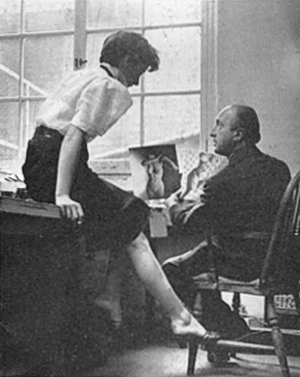
Hungarian born photographer Zoltan Glass shows some of his work to prospective model Marigold Randolph in his London studio.
Continuing with my profiles of 50s and 60s glamour photographers, we have:
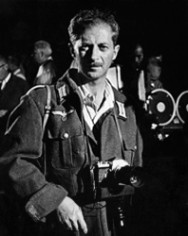
David Sutton on the set of the film "Von Ryan's Express" in 1965.
David Sutton - Back in the 1950s, when many of the great Hollywood photographers vied for the chance to have their glamour work appear in the pages of Playboy (instead of the two or three staff photographers who crank out their slick, predictable and boring pictorials today), you actually got the feeling that you were looking at the work of creative individuals whenever you flipped through the magazine. One of these photographers who had his work featured in the magazine in the late 50s was David Sutton. Sutton made his living photographing many of the top Hollywood actors and actresses on movie sets and in their homes, as well as shooting glamour and pinups. Some of the movie stars he captured on film include: Frank Sinatra, Paul Newman, Charlton Heston, James Garner, John Wayne, Rod Steiger, Burt Lancaster, James Coburn, Roddy McDowell, Steve McQueen, Sean Connery, Stella Stevens, Debbie Reynolds, Lauren Bacall, Joanne Woodward, Doris Day and Joan Collins. His glamour work featured such Hollywood models and actresses as Cheryl Kubert, Barbara Huffman (Barbara Eden), Vikki Dougan, Shirley Kilpatrick, Dane Arden (Elsa Sorenson), Joi Lansing, Sally Todd, Rosemarie Bowe, Marilyn Wesley, Sheila Rudy, Irish McCalla, Dolores Donlon and Susan Harrison. For Playboy, Sutton photographed one of the aforementioned models, Sally Todd for the Feb. 1957 centerfold. Sutton, along with Edward DeLong, photographed Dawn Richard for the May 1957 Playmate pictorial.
A few other Playboy contributions include: Champagne Flight to Vegas - a 5 page pictorial (featuring Sally Todd) for the June 1956 issue and Playboy's Yacht Party - an 8 page pictorial for the July 1957 issue. He also shot the cover for that issue.
David Sutton was born on April 13, 1921 and was a native New Yorker. He took up photography while in his teens and when he was called into service during WWII, it was natural for him to become a combat photographer, flying B-25 missions over China and Burma. After the war, he spent some time doing a bit of freelance photography, worked for Life magazine for a short while, and then headed west for Los Angeles, where the weather and locations made it a perfect playground for glamour photography. Like many of his colleagues in the industry, David felt that having his models show some modesty was essential to good glamour photography. In 1959, he wrote: "A costume that completely hides the figure is as bad as one that reveals too much. When something is left to the imagination, the mind becomes pleasantly stimulated and the result is provocative glamour."
Camera equipment used by Sutton included commercial view cameras, the 4x5 Graflex and 4x5 Graphic, the Rolleiflex and Nikon (35mm). For color, he used an 8x10 view camera, but for most of his cover work, he used the 4x5 Graflex. For the majority of his glamour picture stories, he used a medium format camera (Rolleiflex) and his 35mm Nikons. Beginning in the late 50s, he used his 35mm camera for much of his glamour work because of the speed and ease of operation.
When shooting B&W, he preferred Kodak Plus-X film for his 35mm and Rollei cameras. He liked UFG film developer because he felt it enabled him to push the film speed up to 1000 ASA without too much difference in grain structure. For 35mm color work, he used Kodachrome and Super Anscochrome. For his Rolleiflex, 4x5 cameras and up, he used Ektachrome, Anscochrome, and Ektacolor films.
Aside from his work in 50s and 60s glamour, Sutton kept busy shooting movie premieres, award ceremonies like the Academy Awards and Golden Globes, and stills on various TV programs (The Monkees, Happy Days, Mork & Mindy) and movie sets (Harper, Von Ryan's Express, Dr. Dolittle, Oh, God, etc.). He was also a model railroading enthusiast who authored (and took hundreds of photos for) The Complete Guidebook of Model Railroading in the late 50s and the hardcover book The Complete Book of Model Railroading in 1964, which was reprinted throughout the 1970s and 80s. David Sutton passed away in Los Angeles, California on Sept. 28, 1998. He was 77 years old.
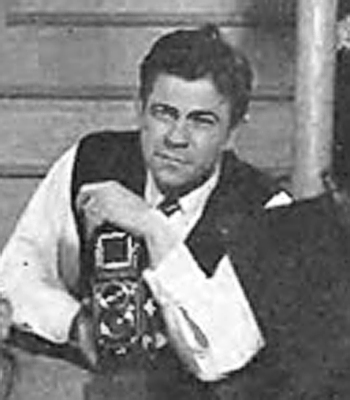
Hal Adams - Hal Adams was an advertising, fashion and glamour photographer who shot ten Playmate pictorials for Playboy between 1955 and 1957. The first appearance of his photography in the magazine was actually in the March 1954 issue which featured a behind-the-scenes look at a photo shoot for the Hartog shirt ad campaign that featured models in various stages of undress (topless or implied topless). The first Hartog model for this campaign was well known figure model Joanne Arnold.
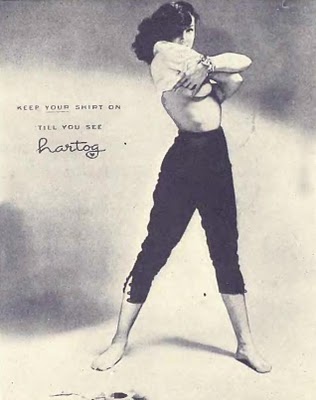
Subsequently, Mr. Adams submitted a photo of Jayne Mansfield to Playboy and it was approved and published as the centerfold for the Feb.1955 issue. His next centerfold was featured in the April 1955 issue (Marilyn Waltz - her second appearance as Playmate under that name), and the month after that, his wonderful photograph of the well known figure and glamour model Marguerite Empey (soon to become known as Diane Webber after her marriage to Joe Webber that same year), graced the pages of the magazine and made her Miss May 1955.
The other seven Playboy Playmates who were photographed by Hal Adams were:
Pat Lawler (Miss Aug. 1955)
Anne Fleming (Miss Sept. 1955)
Jean Moorehead (Miss Oct. 1955)
Jonnie Nicely (Miss Aug. 1956)
Betty Blue (Miss Nov. 1956)
June Blair (Miss Jan. 1957)
Gloria Windsor (Miss April 1957)
Initially, both Jean Moorehead and Jonnie Nicely were photographed by Adams for the Oct. '55 issue, and both women were featured in the issue, but Miss Moorehead was actually named Miss October. After complaints from readers about Miss Nicely not being named a Playmate, Hal Adams' centerfold of her finally made it into the magazine in Aug. of '56.
Jonnie Nicely had been one of Adams' Hartog shirt models when Adams asked if she would consider doing a shoot for Playboy. Of her work with Adams, she once said "It was a modeling job with the finest man for
a photographer I have ever had the honor of working with."
Hal Adams stopped shooting for Playboy in the late 50s when Hefner wanted him to begin featuring more nudity in his photographs. Up until then, his centerfolds had been much like his photographs for the Hartog ads - topless, with the models' breasts being partially obscured.
When it was thought by some Playboy photo archivists that Marilyn Waltz' first appearance as a centerfold (April 1954) might have also been shot by Adams (the '54 pin-up had been bought from the Baumgarth calendar company with no photographer credited), he quickly dispelled that notion; Marilyn's 1954 pose
was far more revealing than he cared to shoot. "I never showed real
nudity," he said. "That's why I used trellises or leotards in my
pictures. I'm not prudish or anything like it, but it's just my own feeling
that a picture is more erotic when the woman has some clothes on."
It turned out that Marilyn Waltz was actually featured as a Playmate three times during the magazine's first 16 months of publication (Hal Adams shot her third and final centerfold appearance). This was because for her first Baumgarth calendar photo, she had used the name of Margaret Scott. This first pinup, purchased by Hefner for his fledgling magazine, made the centerfold of the Feb. 1954 issue, with another Baumgarth shot of Waltz, using her real name, being published in the April '54 issue. Confusing, huh? It wasn't until the 90s that Marilyn finally confirmed that she was both Margaret Scott and Marilyn Waltz.
Hal Adams was born on Sept. 17, 1912 in New York City and studied at the Art Students League in New York. He moved to Los Angeles in the early 50s in the hope of becoming a cinematographer, but when he couldn't find work in the motion picture industry, he turned to still photography. He eventually opened a studio and produced advertising images for Ford, Chevrolet and Lincoln and also photographed celebrities like Cary Grant, Fred Astaire, Johnny Cash and Nancy Reagan for a number of magazines.
After his work for Playboy, Mr. Adams continued shooting fashion and pinups in his Los Angeles studio and also photographed several album covers. He was a good friend to New York fashion photographer Richard Avedon and allowed Avedon to use his studio when in LA. A few of his other close photographer friends included Helmut Newton and Matthew Rolston. Update (11/18/20): I just learned from Richard Litt (Richard Litt Photography, Sherman Oaks, CA) that Hal Adams also taught photography at the Art Center School in Los Angeles. Richard took a class from Mr. Adams in 1979 and found him to be "a very interesting guy" as well as a good teacher.
Hal N. Adams (born Harold Nathaniel Abramoff) passed away on Oct. 9, 2005 at the age of 93.
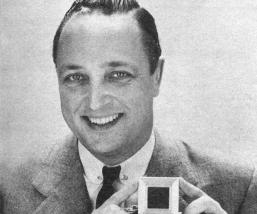
Philip O. Stearns - Philip Olcott Stearns was another well known fashion and glamour photographer of the 50s whose work seems to have been forgotten in recent years, so I decided to write this profile on him.
Philip Stearns was born in Detroit, Michigan on Feb. 9, 1917. He attended the private Brooks School in North Andover, Massachusetts and attended Princeton University where he became a successful rower. At Princeton, he developed an interest in sculpting and later graduated with a degree in art and archaeology. After graduation, Stearns served in WWII as a Captain in the OSS (precursor of the CIA) and was stationed in England, where he worked with the French Resistance. While in the UK, he became a collector of model soldiers. Later in life, he took photographs for many books on model soldiers and even wrote one of his own.
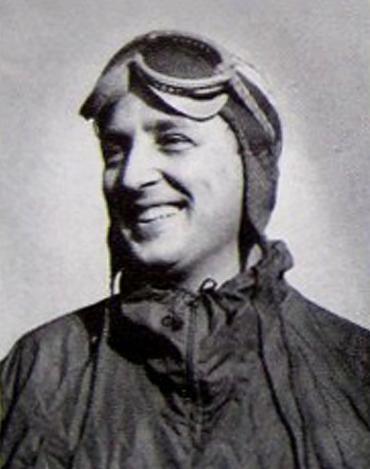
Philip Stearns during WWII
Following WWII, Stearns returned to the U.S. and went into photographic work, eventually moving into the New York penthouse studio once occupied by sculptor Henry Hering. It had been Hering's studio that had been hit by one of the engines of the B-25 bomber that struck the Empire State Building on July 28, 1945. The engine had passed through the Empire State Building and crashed through the skylight of the nearby penthouse studio. When the roof was repaired, the existing skylight was expanded, which would later suit Stearns photographic style very well. Philip Stearns' fashion photography was much in demand in the early 50s and he also delved into glamour and nude photography. His fashion work was published in such magazines as Town and Country, Harper's Bazaar and Vogue and his glamour images appeared in Art Photography, Figure Quarterly, Good Photography, Candid Photography and Prize Winning Photography. He also shot the cover of the Feb, 1955 issue of Sports Illustrated, which featured model Betty di Bugnano wearing a swimsuit. In 1958, Stearns was one of ten photographers who photographed fashion model Betty Biehn for the photo book,The Model. Later, in 1966, he co-authored a book of artistic nudes that was entitled Six Nymphets.
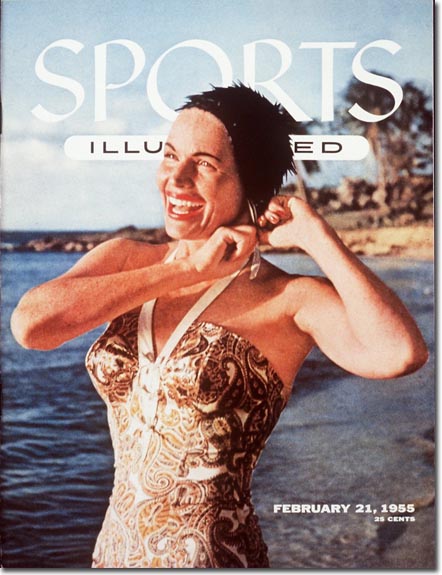
Philip Stearns shot the cover for this Feb. 21, 1955 issue of Sports Illustrated.
Stearns was one of ten photographers who captured model Betty Biehn on film for the book The Model (1958).
At the current time, I've found three contributions that Philip Stearns made to Playboy magazine, but they surprisingly did not involve photographing a glamorous model. In the April 1957 issue of the magazine, Philip Stearns did the lush color photography of several sports cars for an article in the Modern Living section entitled The Compleat Sports Car Stable. Coincidentally, the fashion model Betty Biehn, who Stearns would later photograph for the book The Model (above), appeared in that same issue, with a few behind-the-scenes shots of her being photographed nude by another photographer. Stearns also contributed one photo to illustrate an article called Summer in the City in the Aug. 1958 issue and one photo for an article called Man of Affairs in the Oct. 1958 issue.
Stearns' camera of choice for his fashion and glamour work was the medium format Hasselblad, but he also used 35mm cameras as well as a studio view camera. In the early to mid 50s, Stearns preferred to use his big skylight, as well as bounced tungsten lights so that he could "see" his lighting. He also preferred constant lighting because many models still tensed up and flinched when being photographed by strobes. Outdoors, he preferred to shoot in the shade, either under trees or in the shade or porches. He once wrote, "Anything with a woman is better in soft sunlight. Direct sunlight is something I hate. It's harsh, crisp, and always unkind." Like most glamour photographers, he also preferred dancers as models. "Dancers are my best models", he said in 1956. "They know how to move or to rest."
In the 1950s, Stearns augmented his fashion and glamour work with occasional commercial and industrial assignments, as well as photographing stars such as Joan Fontaine, Eva Gabor and Faye Emerson.
In the mid to late 60s, Philip returned to England where he had been stationed during WWII, and became a photographer for Penthouse magazine, and for a time, the photographic director for the magazine. He also shot for other British men's magazines, such as Mayfair. In addition to this, he shot stills for the British skin flick The Love Box in 1972. After leaving Penthouse, he became editor of the military history magazine Campaign and was also involved with The Sealed Knot - the English civil war re-enactment organization, which had been founded in 1968. He also continued with his interest in military miniatures, and published his own book, How to Make Model Soldiers, in 1974.
Philip Stearns died on Feb. 11, 2000 in Dorset, Vermont, just two days past his 83rd birthday. He had been married and divorced three times but had always maintained a cordial relationship with his ex-wives. I will always remember Philip Stearns for his excellent glamour work from the 1950s (such as this photo).
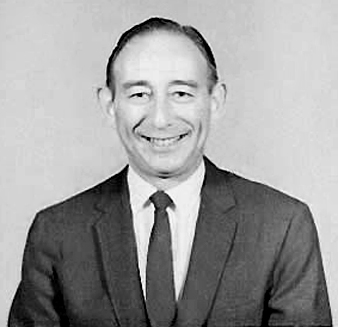
Special thanks to Margaret Jacome for providing the photo of Eric Herman, as well as some additional information about his life and photographic work.
Eric Herman - Mr. Herman was another glamour photographer located in the Los Angeles area, having a studio and home located in Hermosa Beach, CA. He photographed many of the popular glamour models of the era and sold them to magazines and books such as Good Photography, Figure, Male Point of View, Pageant, Glamour Parade, Eye, Gala and Vue.
Eric F. Herman was born in New York on Feb. 22, 1915. He began his photographic career while studying in his mother's homeland of England and was already a pro when he set up his studio in the Los Angeles area in 1943. With the glamour boom of the late 40s and 1950s in full swing, Eric immortalized such Hollywood models as Gwen Caldwell, Jackie Hilton, Dawn Oney, Loretta Brintz-Basler, Jane Easton, Lynn Lampert, Margie Moran, Millicent Deming, Virginia de Lee, Trudy Williams and Joyce Reed. The most famous models who posed for Mr. Herman, however, were probably Diane Webber and Barbara Osterman, both of whom were all-time favorite models of Peter Gowland. Eric had a special working relationship with Barbara Osterman since she was also his sister-in-law. In 1950, Barbara had married the brother of Eric's wife Norma, (William) James Neill. Norma, her brother Jim, and Barbara had all grown up in Oregon, and after Barbara and Jim were married, the newlyweds moved to Los Angeles in 1951. However, Barbara had already spent a lot of time there previously, having been born in Ontario, California. Also, in 1949, her soon-to-be husband, W. James Neill, took a photo of her at El Segundo beach that would appear on the cover of the Nov. 1949 issue of U.S. Camera. Below is the cover of the May 1955 issue of U.S. Camera - a swimsuit shot of Osterman that was taken by Eric Herman.
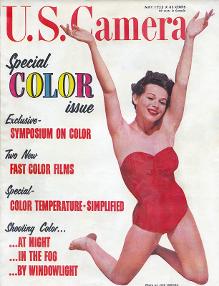
Eric Herman photographed Barbara Osterman for this May 1955 cover of U.S. Camera
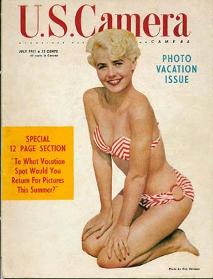
Eric Herman shot this cover photograph of model Loretta Brintz-Basler for the July 1951 issue of U.S. Camera
Mr. Herman also photographed glamour nudes as well as some artistic nudes. Some of his nude models included Diane Webber, Madeline Castle, Joanne Carroll and Virginia de Lee.
At the present time, I do not have much detailed information on Mr. Herman's camera equipment other than that he used a Graflex for some of his work, a 4x5 Meridian View camera for some of his magazine covers (he used daylight Ektachrome film for color shots) and a medium format camera (probably either the Rolleiflex or the Hasselblad) for much of his 50s studio work.
After Eric Herman decided to close his studio in the early 60s, he went to work for the Aerospace Corporation in El Segundo, as an industrial photographer. Sometime after his wife Norma passed away in 1993 (at the age of 73), Eric moved to Ashland, Oregon, where Barbara Osterman and her husband Jim had been residing since 1990. At some point, Eric later moved back to Hermosa Beach. Eric Herman died on May 6, 2003, at the age of 88. An unfortunate post script to this profile is the fact that many of Eric Herman's negatives were destroyed when the storage facility in which they were housed became flooded. Only a small percentage of them were able to be salvaged, but luckily, some of the negatives of his most famous models did survive.
Update/Correction (1/6/2023): I only just discovered that Norma Neill did not marry Eric Herman until 1981 so she was not Eric's wife when Eric was photographing Barbara Osterman back in the 50s. Therefore, Barbara and Eric were not related by marriage at that time. It makes me wonder if Barbara Osterman introduced Eric to her sister-in-law Norma a bit later in his life. More research is needed. Eric Herman was married during the 1950s - he had married Joyce A. Bates in 1947 (he was 32 at the time and she was 22), but I can find no information on when they were divorced. According to voter registration records, Eric and Joyce were still living in the same home in 1958, but in the 1960 voter registration document, Eric was the only voter listed at his home address. Could be a clue.
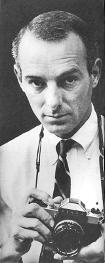
Ed Alexander - Ed Alexander began his photographic career by working as an apprentice to a fashion photographer in London, but in search of greater artistic freedom, he came to the United States and began shooting freelance glamour work with the help of an agent, Al Weiss of Galaxy Photos. After selling his first glamour photo to Popular Photography magazine, he was well on his way. He would later return to London determined to be the best glamour photographer in the country.
Ed's photos appeared in a variety of American publications, including the book 10 Top Glamour Photographers (1959) and Figure Annual (Winter 1963). He also shot for numerous American men's magazines, including Rogue, Cavalier and Modern Man. A few of his magazine shoots included the Feb. 1962 issue of Rogue magazine (Oriel Bivens), Oct. 1962 issue of Modern Man (Pip Grant), the Jan. 1963 issue of Modern Man (Gina Graham), the Nov. 1963 issue of Modern Man (Ann Terry), the Feb. 1965 issue of Rogue magazine (Monica Jordan), the Aug. 1964 issue of Rogue (Gabrielle Monique) and the January 1968 issue of Cavalier magazine (Sally Brewer).
Camera equipment used by Mr. Alexander in the late 50s and early 60s included the medium format cameras Hasselblad and Rolleiflex and also 35mm Leica and Canon cameras. One of his favorite b&w films in the early days was Ilford FP3.
After returning to England, Ed photographed numerous glamour models and had a few books of his photos published, including Ed Alexander's Female Figure Photography (1962), Ed Alexander Photographs English Beauties (1964) and English Glamor Models (1966).
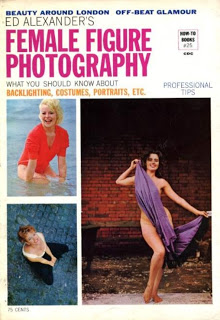
Some of Alexander's models included: Nancy Roberts, Nicky Lawrence, Bernadette Kell, Wendy Luton, Frankie Young, June Palmer, Terry Higgins, Sylvia Munoz, Janice Allen, Penny Langley, Sophie Dom, Suzanne Rainer, Marie Barry, Lorna Tern, Vicki Kennedy, Ann Walker and Linsay Dale.
In 1963, Ed commented that the most rewarding part of his career was "knowing that I have achieved a certain amount of success in the field...and secure in the knowledge that I will learn even more and accomplish much in the future."
After his return to England, Ed also began shooting for the British men's magazine Mayfair in the late 60s and early to mid 70s.
The latest information that I have on Ed Alexander is that in 2009 he was 80 years old and living with his wife, a former glamour model who he had met in London in the 1970s. Update: I have just seen a report that Ed passed away on Oct. 29, 2014.
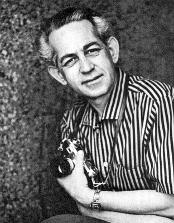
Ed Braslaff - Ed Braslaff was born on Feb. 9, 1911 in Philadelphia, Pennsylvania, and at the age of 16 received his first camera. He began his professional career when he started taking photos for school annuals with another photographer. He and his partner travelled throughout Ohio, Indiana, and Michigan until WWII came along. During the early years of the war, Ed worked with the civilian branch of the Army Signal Corps, taking identification photos. In 1943, he moved to Los Angeles and got a job as a staff photographer for the CBS network where he photographed such stars as Jack Benny, Burt Lancaster, Joseph Cotten and Leslie Caron. He stayed with CBS until 1952 when he switched to freelance photography.
Ed initially began his freelance career shooting for movie fan magazines, photographing stars like Marilyn Monroe, Sophia Loren, Clark Gable and Groucho Marx. In August of 1956, he photographed Elvis Presley at the Knickerbocker Hotel in Hollywood for a fan magazine. Not long after this, Ed switched to glamour photography since most of the fan magazines had their own staff photographers. Ed's glamour photos would be published in such men's magazines as Escapade and Stag, as well as being featured in the 1957 edition of Best Photography. For Playboy, Ed shot a 3 page pictorial called A Toast to Legs for the June 1958 issue. A few of Braslaff's models included Yvette Vickers, who would later become Playboy's Miss July 1959 (photographed by Russ Meyer), and Dorothy Johnson, the first runner-up in the 1956 Miss America Contest and an up and coming film and television actress.
Ed shot with a Rolleiflex and some 35mm cameras and often used Tri-X as his film of choice. He also did all of his own b&w film developing and printing in his Los Angeles apartment.
Ed Braslaff passed away on March 15, 1988 in Los Angeles at the age of 77. At his estate auction in 1991, Braslaff's negatives of Elvis Presley sold for well over $10,000 and the photos would later be published in a book entitled Elvis: 1956 Reflections.
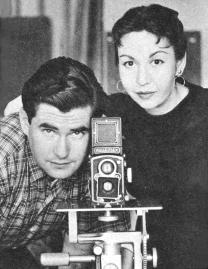
Barbara and Justin Kerr - A husband and wife photography team who worked (and continues to work) out of their New York City studio, Barbara and Justin Kerr photographed two Playboy Playmates in the 1950s and 60s - Miss April 1959, Nancy Crawford and Miss Feb. 1962, Kari Knudsen.
Justin Kerr was born in the Bronx and served as an army medic in Japan after WWII. He later left premed studies at New York University to study photography and art. Barbara had lived near Justin in the Bronx and they would eventually marry and start their photography business in 1950. The Kerrs concentrated on fashion and glamour photography in the late 50s and early 60s, and in addition to Playboy, would photograph models for Young Miss and Ingenue, as well as shooting thirty-six covers for Teen Magazine and American Girl. It was Barbara who was in charge of supervising the makeup on all their models, helping them conceal temporary blemishes and the defects that one does not normally see with the naked eye (but is picked up by the camera lens).
The Kerrs' glamour work could be seen in many of Fawcett's photography digests of the late 50s/early 60s, such as Prize Winning Photography (1959) pages 20 and 143, Candid Photography (1959) page 109, Good Photography (1960) #461 pages 73, 77, and 88, Good Photography (1960) #504 page 114, Prize Winning Photography (1960) pages 21 and 101, Candid Photography (1960) pages 115 and 137, Prize Winning Photography (1963) page 72 and Candid Photography (1964) page 93. Some of their other glamour work could be seen in the books The Technique of Figure Photography (1959) and Glamor Photos (1962)
A few of the models photographed by Barbara and Justin Kerr included: Germaine Blondel, Lenore Marcia, Millicent Rand (December 1959 issue of Escapade), Sandra Bowman, Carrie Radison, Jean Woodworth, Amar Basra, Marlene King, Joan Wolfe, Nancy Crawford, Jacqueline Valenci and Kari Knudsen.
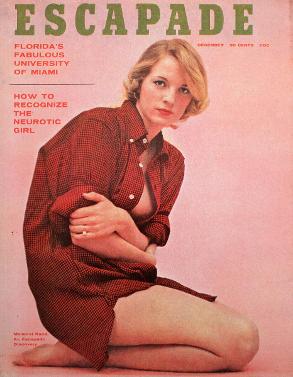
Camera equipment included an 8x10 view camera (used for their Playmate centerfolds) and the medium format Hasselblad and Rolleiflex, as well as Nikon 35mm cameras. For their B&W photos, they often used Tri-X film.
A turning point in the Kerr's career took place during their first vacation to Mexico in 1959. They became enamored of the history and art of the Maya civilization and set about to take photos of every Pre-Columbian artifact that they could find. In 1974, Justin designed and constructed a camera that would be able to make a continuous photograph of the elaborate art work on Maya vases and pots as they were rotated in front of the camera. These rollout photos helped scholars decipher the glyphs on the vases and give a new view of the Maya. By 1978, the Kerrs were dedicated to photographing Pre-Columbian art exclusively and have become renowned worldwide for their work in this field.
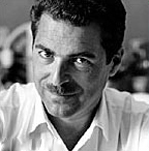
Pompeo Posar - This is a profile that has been much too long in coming, but I only recently uncovered some details of this Playboy photographer's early life.
Pompeo Posar was of Italian descent, having been born in Trieste, Italy on Feb. 21, 1921, but grew up in Zagreb, Yugoslavia. His father hoped he would join the family import-export business, but fortunately for the world of glamour, he bought his son a Leica camera at age 15. Pompeo took to his new hobby with a passion and took photos at school and at the Folies Bergeres on a trip to Paris. Having a propensity for taking photos of pretty girls, one day at the beach he asked a beautiful woman in a bikini if he could take her picture. Her name was Melita and he would propose to her in 1947. To support himself and his wife, he became a freelance photographer.
In 1955, the two moved to Chicago, but because Pompeo initially spoke no English, his first job was working in a darkroom for a dollar an hour. In his first week in the U.S., he came across the premier issue of Playboy. From the moment he saw the magazine, it was Pompeo's dream to shoot photos for them. Four years later, in 1959, a doctor friend suggested that Posar might want to take some nudes of a student nurse he was going out with. The nurse agreed and Posar was so pleased with the results that he got up the nerve to walk into the Playboy office in Chicago without an appointment. Playboy photo editor Vince Tajiri looked at the photos and announced that he wanted to use one of them for the magazine's gatefold. Pompeo went back to the nurse, but she got nervous at the thought of being in Playboy and said "no". When he tried to call Playboy back to tell them, Tajiri's secretary didn't understand who he was and unceremoniously hung up on him.
In early 1960, Posar was shooting stills on the set of the local ABC television station. The show being taped in the adjacent studio was, luckily enough, Playboy's Penthouse. Pompeo began photographing all the beautiful women as well as Hefner himself. He happened to get an especially nice photo of Hefner and he blew it up large and later presented it to the Playboy founder. Hefner liked it and at once asked Posar if he wanted a job. "Oh, this is my dream" said Posar. Hefner's response to this was "Why didn't you say so before?" The next time they met, Vince Tajiri stared at Posar and said "I've been looking for you!"
Within his first few years at Playboy, Pompeo would photograph two centerfolds for the magazine, as well as helping Mario Casilli shoot the 1961 Playmate of the Year pictorial (Linda Gamble) and doing The Girls of Rome pictorial, the first of Playboy's many regional photo essays.
During the 1960s, Pompeo Posar would go on to shoot 26 Playmate pictorials. They are: Jan Roberts (Miss Aug. 1962), Laura Young (Miss Oct. 1962) - (Pompeo's first centerfold, as it was shot before Jan Roberts), Connie Mason (Miss June 1963), Phyllis Sherwood (Miss Aug. 1963), Donna Michelle (Miss Dec. 1963) - (Pompeo shot the gatefold only as Edmund Leja did the rest of the photography), Sharon Rogers (Miss Jan. 1964). Nancy Jo Hooper (Miss Feb. 1964), Ashlyn Martin (Miss April 1964). Terri Kimball (Miss May 1964), China Lee (Miss Aug 1964), Rosemarie Hillcrest (Miss Oct. 1964), Kai Brendlinger (Miss Nov. 1964), Sally Duberson (Miss January 1965), Jennifer Jackson (Miss March 1965), Pat Russo (Miss Nov. 1965), Dinah Willis (Miss Dec. 1965), Dolly Read (Miss May 1966), Dianne Chandler (Miss Sept. 1966), Britt Fredriksen (Miss June 1968), Melodye Prentiss (Miss July 1968), Majken Haugedal (Miss Oct. 1968), Cynthia Myers (Miss December 1968), Sally Sheffield (Miss May 1969), Helena Antonaccio (Miss June 1969), Claudia Jennings (Miss Nov. 1969) and Gloria Root (Miss Dec. 1969).
He also shot Playmate of the Year pictorials for Linda Gamble (1961, as mentioned above), June Cochran (1963), Donna Michelle (1964) as well as additional photo shoots for Playmates Patti Reynolds (Stan Malinowski shot her centerfold), Unne Terjesen (Mario Casilli), and Susan Denberg (Peter Gowland). Pompeo Posar would go on to shoot a total of 65 published gatefolds and more than 40 covers for Playboy during his long career with the magazine.
Pompeo was much loved at Playboy for his charm, and he photographed many of the all-time classic centerfolds. Among them is my favorite, Miss December 1963, Donna Michelle. To hear a few of the Playmates he photographed talk about how endearing he was, take a listen to the following interview clip.
Dianne Chandler and Helena Antonaccio.mp3
Pompeo Posar passed away at the age of 83 on April 5, 2004 in Chicago, Illinois, after an illness. A loving tribute to the photographer, featuring several of his photos, was published in the December 2004 issue of Playboy.
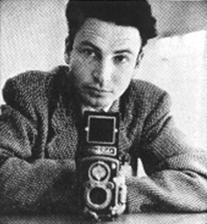
Don Ornitz - Don Ornitz was another Hollywood photographer who began his career in the military during WWII and went on to great success in the glamour field after the war. He would eventually photograph many of the top movie stars of the day as well as countless glamour models.
Donald R. Ornitz was born in New York City on February 29, 1920, the son of novelist and screenwriter Samuel Ornitz. After the family's move to Hollywood, Don discovered the camera at the age of fifteen. At that stage, he was mostly interested in shooting what he called "personality portraits" - aiming his camera at Yugoslav fisherman and Mexican laborers, for example. He would spend a lot of time in the darkroom and also eagerly followed the works of Edward Weston and Dorothea Lange.
During WWII, Don enlisted and was assigned as a photographer to the 166th Photo Co. with the 4th Armored Division and covered events like the Battle of the Bulge, the discovery of the plundered art treasures that the Germans had hidden in a salt mine, and the Nazi atrocities that were committed at the Buchenwald concentration camp. Many of his photos were used as evidence during the Nuremberg Trials.
Back in Hollywood after the war, Don joined the staff of a movie fan magazine and in 1950 he became a freelance photographer, doing work for such magazines as Life, Ladies' Home Journal, Saturday Evening Post, Look, Pageant, and Coronet as well as many foreign periodicals. He did several color photo essays for Life, which included "Water Sprites", "Swim Suits in a Rain Forest" and "Olympic Girls". For Playboy's May 1958 issue, Don did a 3 page pictorial featuring Tina Louise and Aldo Ray entitled "Playboy's Little Acre". For the Jan. 1960 issue of Playboy, Don Ornitz shot the b&w photos of Playmate Stella Stevens and in the Sept. 1971 issue, his photos illustrated the 12 page pictorial "Girls of the Golden West". For the movies, Don was hired to shoot the still photos of the young women featured in the title sequence of the 1964 Howard Hawks comedy "Man's Favorite Sport", which you can see here:
Don's career in glamour photography would take him around the U.S. and to the South Sea Islands, Japan and Mexico.
In 1959, Don Ornitz authored a book of his photography entitled Living Photography (which was reprinted in 1962 and 1966), but also contributed to other photography books including Photographing Glamour (1959) and Figure Studies by Famous Photographers
(1965). He also contributed articles and photos to Salon Photography
(1957) - "Offbeat Glamour", Candid Photography (1958) - "Candid Glamour
Portraits", and Good Photography (1959) - "The Anatomy of Glamour".
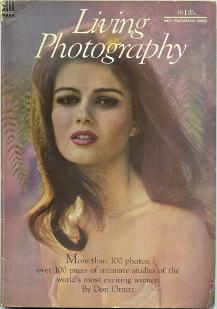
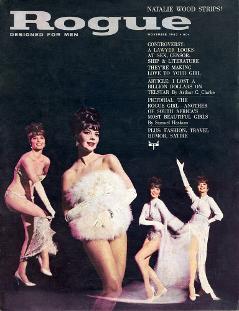
Some of the innumerable models and actresses photographed by Mr. Ornitz include: Marilyn Monroe, Vikki Dougan, Judy Warner, Cindy Gray, Cheryl Kubert, Abby Dalton, Venetia Stevenson, Carole Wells, Sandra Dee, Gia Scala, Tina Louise, Jacquelyn Ebeir, Inger Stevens, Barbara Wilson, France Nuyen, Yvette Mimieux, Natalie Wood, Ann Blyth, Julie Newmar, Claudia Cardinale, Brigitte Bardot, Audrey Hepburn, Juliet Prowse, Diane Webber, Dorothy Malone and Hope Lange.
When shooting black and white outdoors, he used Plus-X film exposed at ASA 160 and developed it for 14 minutes at 68 degrees in Microdol. Where there was less light, he used Tri-X exposed at ASA 500 to ASA 1000 and developed the film in Promicrol at 68 degrees for 10 to 15 minutes.
For lighting indoors, he supplemented natural light with No. 1 photofloods placed in existing fixtures, or by bouncing No. 2 photofloods off the ceiling or walls.
For 35mm color, Don used Kodachrome, which he felt was the most color-consistent film on the market and had the finest resolution.
Don Ornitz' tremendous career in glamour photography was tragically cut short when he took his own life on January 14, 1972. He was only 51 years old.
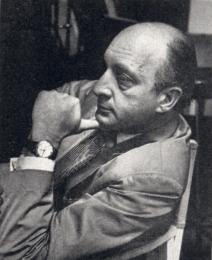
Zoltan Glass - I first became aware of Zoltan Glass around 2008 when I saw some of his images in the Good Photography and Salon Photography books that I had purchased on ebay. One particular image that really impressed me was this one, from the 1951 edition of Good Photography. In the 1953 edition of Salon Photography, Zoltan Glass authored an article (with photos) called "The Sculptured Nude". As my collection of books and magazines from that era grew, I began to see more and more of Zoltan Glass's work.
Zoltan Glass was born in Budapest, Hungary on April 26, 1903 to a Jewish couple named Reszon and Olga Glass. Zoltan began his career as a cartoonist and retoucher for a local newspaper, but in 1925 he moved to Berlin, Germany, eventually finding work as the picture editor of a Berlin evening paper. In 1931, he gained employment as a photojournalist on the more important daily, the Berliner Tagblatt. Glass was soon able to also prosper as a freelance commercial photographer and journalist.
A keen motorsport enthusiast and amateur racer, Glass covered most of the big races in Berlin. His photos capturing the success of the Mercedes-Benz team received immediate and widespread public acclaim. Glass's motoring work also included documentary photographs taken at car shows and factories, plus publicity shots commissioned by clients such as Daimler-Benz, Auto Union and Shell.
Following Kristallnacht in November 1938, the Nazis introduced laws that prevented Jews from owning or running any type of business, and Glass's relationship with Mercedes, Auto Union and other clients were terminated. He was forced to flee Berlin, taking with him his entire collection of negatives.
Glass settled in London, where he was given work by another Jewish refugee, Arthur Sringarn, owner of Sackville Advertising. After the war, Glass took up British nationality, but the immediate post-war years were a difficult time for all commercial photographers and he was forced to eke out a living taking publicity stills for clients in the film and theatrical worlds.
By 1948, Glass began shooting photo stories for Lilliput, a pocket-sized gentlemen's magazine, and as a result of this association, he began to concentrate on shooting nudes.
In the early 50s, Zoltan Glass's artistic nude images began appearing in American publications like Good Photography and Art Photography and by 1952 and 1954, entire issues of Figure Photography Annual would feature the nude photography of Zoltan Glass. By this time, Glass had established his own studio in the Chelsea district of London, a section full of artists, studios and show people.
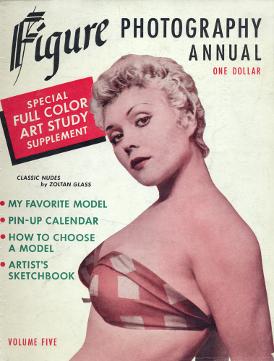
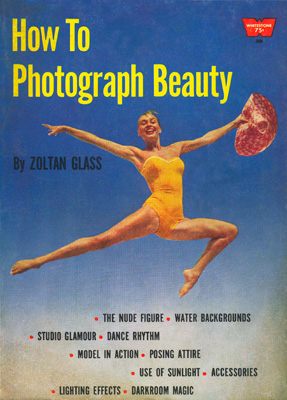
Glass's nude work was usually quite intricate, with the fantasy elements being painstakingly created by Glass and his set designer and scenic painter, London artist James Hull. In one instance, giant playing cards were needed as props, and they were created in Glass's studio. For a Victorian themed shoot, care was taken that everything be authentic. Wallpaper, furniture, props, garments and hair-dos were researched carefully. For an Egyptian themed shoot, with Pamela Green as Cleopatra, Glass and James Hull conducted careful research in books and museums, then designed, built and painted the background. Of model Pamela Green, Glass wrote: "Miss Green is an artist herself and she falls easily into natural, comfortable poses. She follows every suggestion of the photographer with understanding."
Some of Glass's other models included: Marigold Randolph, Adele Vendraux, Enid Egmont, Peggy Phillips, Hilary Bretton, Daphne Severne, and Juanita Page (one of Zoltan Glass's favorite models).
I have not yet read anything on Glass's choice of cameras or film, but from some behind-the-scenes photos I've seen, it appeared that he used a Rolleiflex for much of his black and white work.
If I have one complaint with Zoltan Glass's excellent work, it is that he (just like his fellow British figure photographer Eva Grant) would often shoot full frontal nude photos of his models, with the pubic area being "erased" during printing. American photographers of that era would usually hide the area with clothing or by an appropriate pose or prop, which I find preferable.
By 1964, Glass had made enough to sell his Chelsea studio to a consortium of British photographers and move abroad to a villa on the French Riviera with his common-law wife Pat, a former cabaret dancer. He offered his collection of pin-up photography to fellow figure photographer Harrison Marks, who strangely turned him down. Zoltan Glass died in France on Feb. 24, 1981 at the age of 78, leaving neither offspring or a will.
Much of the biographical data from the above profile was taken directly from the Zoltan Glass website - http://www.zoltanglass.co.uk/